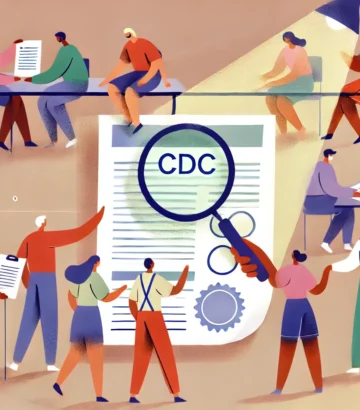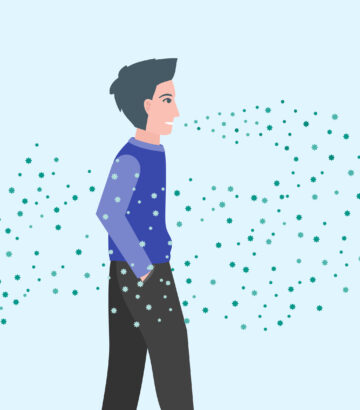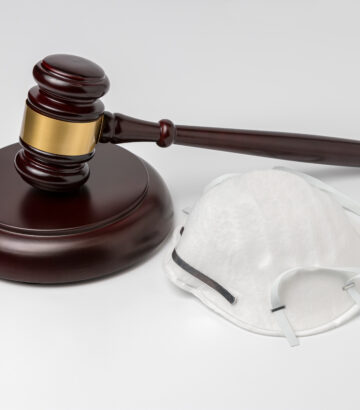IQA Request for Correction: CDC Guidance on Population Immunity to COVID-19
November 6, 2024
Subject: IQA Request for Correction: CDC Guidance on Population Immunity to COVID-19
From: Yaneer Bar-Yam
To: InfoQuality@cdc.gov
CDC/ATSDR Office of Science Quality
By e-mail: InfoQuality@cdc.gov
Dear Sir/Madam,
I am writing to file a request for correction under the Information Quality Act (IQA) regarding the consistency and scientific validity of the guidance provided by the Centers for Disease Control and Prevention (CDC).
Specifically, I am requesting an official correction to address the following issue:On the CDC’s Respiratory Virus Guidance Update Frequently Asked Questions webpage, [1] most recently reviewed on March 25, 2024, the CDC states the following:
“Population immunity to COVID-19 is high: More than 98% of the U.S. population now has some protective immunity against COVID-19 from vaccination, prior infection, or both.”
There are several specific reasons why this information is in error:
First, there is no citation to the claim that 98% of the US population has some protective immunity against COVID-19.
Second, the CDC does not justify the adequacy of the protective immunity that is present in preventing harm including Long COVID symptoms and organ damage, hospitalizations, and deaths in the general population or in specific populations such as those in specific occupational exposure conditions such as front line workers, and those who are particularly vulnerable with immune deficiency due to organ transplants or other circumstances, kidney disease, heart disease, pregnancy, or other conditions.
Third, immunity has been found to wane among those who achieved immunity either through vaccination or infection. [Reference list A] This means that even if we know for certain that 98% of people were infected or vaccinated (or both), we cannot possibly know what percent of people have “some protective immunity against COVID-19,” or the degree of the immunity that they have, because infections and vaccinations occurred at various times. Since “some protective immunity” is not defined by the CDC, this language provides a dangerous false sense of security to those who were infected or vaccinated years ago and have virtually no protective immunity, or inadequate protective immunity to prevent hospitalization, death or Long COVID symptoms and organ damage.
Fourth, we know that vaccines have not been updated quickly enough to keep up with the viral evolution and mutations, and immunity from one variant of COVID does not translate to immunity from another variant of COVID due to immune escape. [Reference list B] This is apparent as were this not the case, new vaccines and boosters would not be needed.
Fifth, prior infections may cause immune system dysregulation that may reduce immunity rather than increasing it. [Reference list C]
Sixth, the very observation of high levels of infection, reaching over a million per day in the winter of 2023 and summer of 2024, accompanied by increasing cases of long COVID, hospitalizations, and deaths which recently have been reported to be over 1,000 per week, demonstrate that adequate protective immunity is not present. [Reference list D] Since the pandemic has been ongoing for over four years, and numerous variants have been the dominant variant at one time or another, the ambiguous phrase “some protective immunity” neglects to address that the immunity some gained to earlier variants from vaccination or infection is not a factor in preventing infection from the current dominant variant(s). There is no established way to predict how SARS-CoV-2 will evolve, so claiming that people have “some protective immunity” based on vaccination for, or infection from, variants that are different from the current dominant variant is misleading, unscientific, and puts people following the CDC’s guidance in direct harm. Due to the high level of immune escape of SARS-CoV-2, the approach of relying almost entirely on vaccine- and infection-based immunity allows SARS-CoV-2 to circumvent the immune response through evolutionary dynamics.
Seventh, Immunity via vaccination only partially protects against development of Long COVID and infections do not protect against long COVID, which is apparent as it becomes increasingly likely with cumulative infections. [Reference list E]
Offering guidance for people to rely on infection-based immunity—which likely has waned and may not provide substantial protection against COVID-19, and can even increase vulnerability to infections due to immune dysregulation—directly risks exposing people to COVID-19 reinfection. Since we know each reinfection results in greater cumulative likelihood of a resulting Long COVID case, this guidance endangers people to both acute infection and reinfection as well as Long COVID.
I recommend that the CDC remove any guidance that provides people with a false sense of security by implying they can rely merely on ill defined “protective immunity” due to infection or vaccination induced immunity. As immunity is not nearly as high as stated, the CDC should be clear in its messaging that in addition to vaccination, people should engage in multiple layers of protection including wearing masks, filtering and ventilating the air, testing regularly, and avoiding crowded spaces.
As a person living in the United States during the ongoing COVID-19 pandemic, I am personally affected by this misleading guidance because it presents outdated and incorrect information to those around me who may become infected with COVID and continue spreading it. Further, due to the contagious nature of SARS-CoV-2, any ineffective, incorrect, outdated, or misleading guidance poses significant threat to all people globally.
References:
[1] https://www.cdc.gov/respiratory-viruses/guidance/faqs.html?CDC_AAref_Val=https://www.cdc.gov/respiratory-viruses/guidance/faq.html
[Reference list A]: Immunity waning undermines immunity
[A.1] Menegale F, Manica M, Zardini A, et al. Evaluation of Waning of SARS-CoV-2 Vaccine–Induced Immunity: A Systematic Review and Meta-analysis. JAMA Netw Open. 2023;6(5):e2310650. doi:10.1001/jamanetworkopen.2023.10650 https://jamanetwork.com/journals/jamanetworkopen/fullarticle/2804451
[A.2] How long does immunity last after COVID-19 vaccination? Does immunity wane faster in certain sub-populations? How safe and effective are booster doses of COVID-19 vaccine? HSE Library https://hselibrary.ie/how-long-does-immunity-last-after-covid-19-vaccination-does-immunity-wane-faster-in-certain-sub-populations-how-safe-and-effective-are-booster-doses-of-covid-19-vaccine/
[A.3] Shrotri M, Navaratnam AMD, Nguyen V, Byrne T, Geismar C, Fragaszy E, Beale S, Fong WLE, Patel P, Kovar J, Hayward AC, Aldridge RW; Virus Watch Collaborative. Spike-antibody waning after second dose of BNT162b2 or ChAdOx1. Lancet. 2021 Jul 31;398(10298):385-387. http://doi.org/10.1016/S0140-6736(21)01642-1
[A.4] Collie S, Nayager J, Bamford L, Bekker L-G, Zylstra M, Gray G. Effectiveness and durability of the BNT162b2 vaccine against Omicron sublineages in South Africa. N Engl J Med 2022;387:1332–3. http://doi.org/10.1056/NEJMc2210093
[A.5] Stowe, J., Andrews, N., Kirsebom, F. et al. Effectiveness of COVID-19 vaccines against Omicron and Delta hospitalisation, a test negative case-control study. Nat Commun 13, 5736 (2022). https://doi.org/10.1038/s41467-022-33378-7
[A.6] Goldberg Y, Mandel M, Bar-On YM, Bodenheimer O, Freedman L, Haas EJ, Milo R, Alroy-Preis S, Ash N, Huppert A. Waning Immunity after the BNT162b2 Vaccine in Israel. N Engl J Med. 2021 Dec 9;385(24):e85. http://doi.org/10.1056/NEJMoa2114228
[A.7] Goldberg Y, Mandel M, Bar-On YM, Bodenheimer O, Freedman LS, Ash N, Alroy-Preis S, Huppert A, Milo R. Protection and Waning of Natural and Hybrid Immunity to SARS-CoV-2. N Engl J Med. 2022 Jun 9;386(23):2201-2212. http://doi.org/10.1056/NEJMoa2118946
[A.8] Polivka, L.; Valyi-Nagy, I.; Szekanecz, Z.; Bogos, K.; Vago, H.; Kamondi, A.; Fekete, F.; Szlavik, J.; Surjan, G.; Surjan, O.; et al. Waning of SARS-CoV-2 Vaccine Effectiveness in COPD Patients: Lessons from the Delta Variant. Vaccines 2023, 11, 1786. https://doi.org/10.3390/vaccines11121786
[A.9] Ishii, T., Hamada, K., Jubishi, D. et al. Waning cellular immune responses and predictive factors in maintaining cellular immunity against SARS-CoV-2 six months after BNT162b2 mRNA vaccination. Sci Rep 13, 9607 (2023). https://doi.org/10.1038/s41598-023-36397-6
[A.10] Yamamoto S, Oshiro Y, Inamura N, Nemoto T, Horii K, Okudera K, Konishi M, Ozeki M, Mizoue T, Sugiyama H, Aoyanagi N, Sugiura W, Ohmagari N. Durability and determinants of anti-SARS-CoV-2 spike antibodies following the second and third doses of mRNA COVID-19 vaccine. Clin Microbiol Infect. 2023 Sep;29(9):1201.e1-1201.e5. http://doi.org/10.1016/j.cmi.2023.05.020
[A.11] Contie, V., Why protective antibodies fade after COVID-19 vaccines, NIH, https://www.nih.gov/news-events/nih-research-matters/why-protective-antibodies-fade-after-covid-19-vaccines
[A.12] Nguyen DC, Hentenaar IT, Morrison-Porter A, Solano D, Haddad NS, Castrillon C, Runnstrom MC, Lamothe PA, Andrews J, Roberts D, Lonial S, Sanz I, Lee FE. SARS-CoV-2-specific plasma cells are not durably established in the bone marrow long-lived compartment after mRNA vaccination. Nat Med. 2024 Sep 27. http://doi.org/10.1038/s41591-024-03278-y
[Reference list B]: Variant evolution immune escape undermines immunity
[B.1] Khan, K., Karim, F., Ganga, Y. et al. Omicron BA.4/BA.5 escape neutralizing immunity elicited by BA.1 infection. Nat Commun 13, 4686 (2022). https://doi.org/10.1038/s41467-022-32396-9
[B.2] Cao, Y., Wang, J., Jian, F. et al. Omicron escapes the majority of existing SARS-CoV-2 neutralizing antibodies. Nature 602, 657–663 (2022). https://doi.org/10.1038/s41586-021-04385-3
[B.3] Pulliam JRC, van Schalkwyk C, Govender N, von Gottberg A, Cohen C, Groome MJ, Dushoff J, Mlisana K, Moultrie H. Increased risk of SARS-CoV-2 reinfection associated with emergence of Omicron in South Africa. Science. 2022 May 6;376(6593):eabn4947. http://doi.org/10.1126/science.abn4947
[B.4] Planas, D., Saunders, N., Maes, P. et al. Considerable escape of SARS-CoV-2 Omicron to antibody neutralization. Nature 602, 671–675 (2022). https://doi.org/10.1038/s41586-021-04389-z
[B.5] Hachmann, N. P., Miller, J., Collier, A. R. Y., Ventura, J. D., Yu, J., Rowe, M., et al. (2022). Neutralization escape by SARS-CoV-2 Omicron subvariants BA. 2.12.1, BA.4, and BA.5. New England Journal of Medicine, 387(1), 86-88. https://doi.org/10.1056/NEJMc2206576
[B.6] Qu P, Faraone J, Evans JP, Zou X, Zheng YM, Carlin C, Bednash JS, Lozanski G, Mallampalli RK, Saif LJ, Oltz EM, Mohler PJ, Gumina RJ, Liu SL. Neutralization of the SARS-CoV-2 Omicron BA.4/5 and BA.2.12.1 Subvariants. N Engl J Med. 2022 Jun 30;386(26):2526-2528. http://doi.org/10.1056/NEJMc2206725
[B.7] Evans JP, Zeng C, Qu P, Faraone J, Zheng YM, Carlin C, Bednash JS, Zhou T, Lozanski G, Mallampalli R, Saif LJ, Oltz EM, Mohler PJ, Xu K, Gumina RJ, Liu SL. Neutralization of SARS-CoV-2 Omicron sub-lineages BA.1, BA.1.1, and BA.2. Cell Host Microbe. 2022 Aug 10;30(8):1093-1102.e3. http://doi.org/10.1016/j.chom.2022.04.014
[B.8] Xia H, Zou J, Kurhade C, Cai H, Yang Q, Cutler M, Cooper D, Muik A, Jansen KU, Xie X, Swanson KA, Shi PY. Neutralization and durability of 2 or 3 doses of the BNT162b2 vaccine against Omicron SARS-CoV-2. Cell Host Microbe. 2022 Apr 13;30(4):485-488.e3. http://doi.org/10.1016/j.chom.2022.02.015
[B.9] Khan, K., Lustig, G., Römer, C. et al. Evolution and neutralization escape of the SARS-CoV-2 BA.2.86 subvariant. Nat Commun 14, 8078 (2023). https://doi.org/10.1038/s41467-023-43703-3
[B.10] Carabelli, A.M., Peacock, T.P., Thorne, L.G. et al. SARS-CoV-2 variant biology: immune escape, transmission and fitness. Nat Rev Microbiol 21, 162–177 (2023). https://doi.org/10.1038/s41579-022-00841-7
[B.11] Moriyama, M., Lucas, C., Monteiro, V. S. & Iwasaki, A. Enhanced inhibition of MHC-I expression by SARS-CoV-2 Omicron subvariants. Proc. Natl. Acad. Sci. U. S. A. 120, e2221652120 (2023). http://doi.org/10.1073/pnas.2221652120
[B.12] Tseng, H.F., Ackerson, B.K., Bruxvoort, K.J. et al. Effectiveness of mRNA-1273 vaccination against SARS-CoV-2 omicron subvariants BA.1, BA.2, BA.2.12.1, BA.4, and BA.5. Nat Commun 14, 189 (2023). https://doi.org/10.1038/s41467-023-35815-7
[B.13] Miller J, Hachmann NP, Collier AY, Lasrado N, Mazurek CR, Patio RC, Powers O, Surve N, Theiler J, Korber B, Barouch DH. Substantial Neutralization Escape by SARS-CoV-2 Omicron Variants BQ.1.1 and XBB.1. N Engl J Med. 2023 Feb 16;388(7):662-664. http://doi.org/10.1056/NEJMc2214314
[B.14] Davis-Gardner ME, Lai L, Wali B, Samaha H, Solis D, Lee M, Porter-Morrison A, Hentenaar IT, Yamamoto F, Godbole S, Liu Y, Douek DC, Lee FE, Rouphael N, Moreno A, Pinsky BA, Suthar MS. Neutralization against BA.2.75.2, BQ.1.1, and XBB from mRNA Bivalent Booster. N Engl J Med. 2023 Jan 12;388(2):183-185. http://doi.org/10.1056/NEJMc2214293
[B.15] Qu P, Xu K, Faraone JN, Goodarzi N, Zheng YM, Carlin C, Bednash JS, Horowitz JC, Mallampalli RK, Saif LJ, Oltz EM, Jones D, Gumina RJ, Liu SL. Immune evasion, infectivity, and fusogenicity of SARS-CoV-2 BA.2.86 and FLip variants. Cell. 2024 Feb 1;187(3):585-595.e6. http://doi.org/10.1016/j.cell.2023.12.026
[Reference list C]: COVID Infection causes immune system dysregulation
[C.1] Diao B, Wang C, Tan Y, Chen X, Liu Y, Ning L, Chen L, Li M, Liu Y, Wang G, Yuan Z, Feng Z, Zhang Y, Wu Y, Chen Y. Reduction and Functional Exhaustion of T Cells in Patients With Coronavirus Disease 2019 (COVID-19). Front Immunol. 2020 May 1;11:827. http://doi.org/10.3389/fimmu.2020.00827
[C.2] Phetsouphanh C, Darley DR, Wilson DB, Howe A, Munier CML, Patel SK, Juno JA, Burrell LM, Kent SJ, Dore GJ, Kelleher AD, Matthews GV. Immunological dysfunction persists for 8 months following initial mild-to-moderate SARS-CoV-2 infection. Nat Immunol. 2022 Feb;23(2):210-216. http://doi.org/10.1038/s41590-021-01113-x
[C.3] Chattopadhyay P, Khare K, Kumar M, Mishra P, Anand A, Maurya R, Gupta R, Sahni S, Gupta A, Wadhwa S, Yadav A, Devi P, Tardalkar K, Joshi M, Sethi T, Pandey R. Single-cell multiomics revealed the dynamics of antigen presentation, immune response and T cell activation in the COVID-19 positive and recovered individuals. Front Immunol. 2022 Dec 2;13:1034159. http://doi.org/10.3389/fimmu.2022.1034159
[C.4] Zheng M, Gao Y, Wang G, Song G, Liu S, Sun D, Xu Y, Tian Z. Functional exhaustion of antiviral lymphocytes in COVID-19 patients. Cell Mol Immunol. 2020 May;17(5):533-535. http://doi.org/10.1038/s41423-020-0402-2
[C.5] Long-term immunological health consequences of COVID-19, British Society for Immunology, August 2020, https://www.immunology.org/sites/default/files/2022-09/BSI_Long_Term_Immunology_Health_Consequences_Covid-19.pdf
[C.6] Song CY, Xu J, He JQ, Lu YQ. Immune dysfunction following COVID-19, especially in severe patients. Sci Rep. 2020 Sep 28;10(1):15838. http://doi.org/10.1038/s41598-020-72718-9
[C.7] Files JK, Boppana S, Perez MD, Sarkar S, Lowman KE, Qin K, Sterrett S, Carlin E, Bansal A, Sabbaj S, Long DM, Kutsch O, Kobie J, Goepfert PA, Erdmann N. Sustained cellular immune dysregulation in individuals recovering from SARS-CoV-2 infection. J Clin Invest. 2021 Jan 4;131(1):e140491. http://doi.org/10.1172/JCI140491
[C.8] Peng X, Ouyang J, Isnard S, Lin J, Fombuena B, Zhu B, Routy JP. Sharing CD4+ T Cell Loss: When COVID-19 and HIV Collide on Immune System. Front Immunol. 2020 Dec 15;11:596631. http://doi.org/10.3389/fimmu.2020.596631
[C.9] Shen, XR., Geng, R., Li, Q. et al. ACE2-independent infection of T lymphocytes by SARS-CoV-2. Sig Transduct Target Ther 7, 83 (2022). https://doi.org/10.1038/s41392-022-00919-x
[C.10] Pan T, Cao G, Tang E, Zhao Y, Penaloza-MacMaster P, Fang Y, Huang J. A single-cell atlas reveals shared and distinct immune responses and metabolic profiles in SARS-CoV-2 and HIV-1 infections. Front Genet. 2023 Mar 13;14:1105673. http://doi.org/10.3389/fgene.2023.1105673
[C.11] Ryan FJ, Hope CM, Masavuli MG, Lynn MA, Mekonnen ZA, Yeow AEL, Garcia-Valtanen P, Al-Delfi Z, Gummow J, Ferguson C, O’Connor S, Reddi BAJ, Hissaria P, Shaw D, Kok-Lim C, Gleadle JM, Beard MR, Barry SC, Grubor-Bauk B, Lynn DJ. Long-term perturbation of the peripheral immune system months after SARS-CoV-2 infection. BMC Med. 2022 Jan 14;20(1):26. http://doi.org/10.1186/s12916-021-02228-6
[C.12] Vazquez-Alejo E, Tarancon-Diez L, Espinar-Buitrago MS, Genebat M, Calderón A, Pérez-Cabeza G, Magro-Lopez E, Leal M, Muñoz-Fernández MÁ. Persistent Exhausted T-Cell Immunity after Severe COVID-19: 6-Month Evaluation in a Prospective Observational Study. J Clin Med. 2023 May 18;12(10):3539. http://doi.org/10.3390/jcm12103539
[C.13] Yin K, Peluso MJ, Luo X, Thomas R, Shin MG, Neidleman J, Andrew A, Young K, Ma T, Hoh R, Anglin K, Huang B, Argueta U, Lopez M, Valdivieso D, Asare K, Deveau TM, Munter SE, Ibrahim R, Ständker L, Lu S, Goldberg SA, Lee SA, Lynch KL, Kelly JD, Martin JN, Münch J, Deeks SG, Henrich TJ, Roan NR. Long COVID manifests with T cell dysregulation, inflammation, and an uncoordinated adaptive immune response to SARS-CoV-2. Nat Immunol. 2024 Feb;25(2):218-225. http://doi.org/10.1038/s41590-023-01724-6
[C.14] Files JK, Boppana S, Perez MD, Sarkar S, Lowman KE, Qin K, Sterrett S, Carlin E, Bansal A, Sabbaj S, Long DM, Kutsch O, Kobie J, Goepfert PA, Erdmann N. Sustained cellular immune dysregulation in individuals recovering from SARS-CoV-2 infection. J Clin Invest. 2021 Jan 4;131(1):e140491. http://doi.org/10.1172/JCI140491
[C.15] See chronological list of 79 references in annotated bibliography: Ewing A. COVID-19 and Immune Dysregulation, a Summary and Resource, WHN communications 4.3 (2023), https://doi.org/10.59454/whn-2303-765
[C.16] Wang L, Davis PB, Berger N, Kaelber DC, Volkow N, Xu R. Association of COVID-19 with respiratory syncytial virus (RSV) infections in children aged 0-5 years in the USA in 2022: a multicentre retrospective cohort study. Fam Med Community Health. 2023 Oct;11(4):e002456. http://doi.org/10.1136/fmch-2023-002456
[C.17] See line items for infection categories in Supplementary Table 2 in Al-Aly Z, Xie Y, Bowe B. High-dimensional characterization of post-acute sequelae of COVID-19. Nature. 2021 Jun;594(7862):259-264. http://doi.org/10.1038/s41586-021-03553-9
[C.18] Pietroluongo E, Luciano A, Peddio A, et al. Exploring the interplay between Kaposi’s sarcoma and SARS-CoV-2 infection: a case series and systematic review. J Med Virol. 2024; 96:e29849. http://doi.org/10.1002/jmv.29849
[C.19] Gershenson C, Bar-Yam Y, Bilodeau S, Heino MTJ, Ewing A, Šalamon Š, Increased Infection Risks After COVID-19 Infections. WHN Science Communications 2024; 5 (3): 1-1.
https://doi.org/10.59454/whn-2403-645
[C.20] Alemu A, Bitew ZW, Seid G, Diriba G, Gashu E, Berhe N, Mariam SH, Gumi B. Tuberculosis in individuals who recovered from COVID-19: A systematic review of case reports. PLoS One. 2022 Nov 28;17(11):e0277807. http://doi.org/10.1371/journal.pone.0277807 https://floradergisi.org/managete/fu_folder/2022-04/2022-27-04-659-663.pdf
[Reference list D]: High rates of infection, deaths, and risk of adverse events from COVID-19 belie claims of widespread immunity
Multiple sources report analysis of available data estimating one million COVID-19 cases per day during high transmission periods in summer 2024, with much higher rates in winter 2023/2024. The CDC has not provided similar analyses. Without publishing its own findings, the CDC is not in a position to challenge the validity of external estimates, should it wish to refute them. Ongoing increases in symptomatic long COVID as a result of new infections confirm their continuing impact on health and limitations on activities. Risks of major adverse cardiac events, including heart attack and stroke, are substantially higher for at least 3 years after COVID infection.
[D.1] Estimate of maximum summer infection rate 2024 at 1.3 million per day: https://pmc19.com/data/
[D.2] Estimate of maximum summer infection rate 2024 at 0.93 million per day: https://x.com/JPWeiland/status/1847410015235424491
[D.3] Estimate of maximum summer infection rate 2024 at 1.8 million per day: https://josepheastman.substack.com/p/pathogen-update-9-21-2024
[D.4] Estimate of maximum this summer between 0.76 – 1.73 million https://whn.global/estimation-of-infections-based-on-wastewater-data-us/
[D.5] In August and September of 2024, the reported deaths from COVID-19 in the US exceeded 1,000 per month. https://covid.cdc.gov/covid-data-tracker/#trends_weeklydeaths_select_00
[D.6] The proportion of the adult population that experienced Long COVID for over 3 months increased from 15% in 2023 to 18% in Summer of 2024, for 8 million additional Long COVID sufferers in addition to others who are ongoing or repeat sufferers. Four out of five long COVID sufferers report activity limitations and one in four have significant activity limitations. https://www.cdc.gov/nchs/covid19/pulse/long-covid.htm
[D.7] Hilser JR, Spencer NJ, Afshari K, Gilliland FD, Hu H, Deb A, Lusis AJ, Wilson Tang WH, Hartiala JA, Hazen SL, Allayee H. COVID-19 Is a Coronary Artery Disease Risk Equivalent and Exhibits a Genetic Interaction With ABO Blood Type. Arterioscler Thromb Vasc Biol. 2024 Oct 9. http://doi.org/10.1161/ATVBAHA.124.321001
[Reference list E]: Neither vaccination nor prior infection provides immunity to Long COVID as Long COVID incidence and severity increases with repeat infections
Vaccination does not provide immunity to Long COVID:
[E.1] Al-Aly Z, Bowe B, Xie Y. Long COVID after breakthrough SARS-CoV-2 infection. Nat Med. 2022 Jul;28(7):1461-1467. http://doi.org/10.1038/s41591-022-01840-0
[E.2] Ayoubkhani D, Bosworth ML, King S, Pouwels KB, Glickman M, Nafilyan V, Zaccardi F, Khunti K, Alwan NA, Walker AS. Risk of Long COVID in People Infected With Severe Acute Respiratory Syndrome Coronavirus 2 After 2 Doses of a Coronavirus Disease 2019 Vaccine: Community-Based, Matched Cohort Study. Open Forum Infect Dis. 2022 Sep 12;9(9):ofac464. http://doi.org/10.1093/ofid/ofac464
[E.3] Taquet M, Dercon Q, Harrison PJ. Six-month sequelae of post-vaccination SARS-CoV-2 infection: A retrospective cohort study of 10,024 breakthrough infections. Brain Behav Immun. 2022 Jul;103:154-162. http://doi.org/10.1016/j.bbi.2022.04.013
[E.4] Van Egeren D, Stoddard M, White LF, Hochberg NS, Rogers MS, Zetter B, Joseph-McCarthy D, Chakravarty A. Vaccines Alone Cannot Slow the Evolution of SARS-CoV-2. Vaccines (Basel). 2023 Apr 16;11(4):853. http://doi.org/10.3390/vaccines11040853
[E.5] Strain WD, Sherwood O, Banerjee A, Van der Togt V, Hishmeh L, Rossman J. The Impact of COVID Vaccination on Symptoms of Long COVID: An International Survey of People with Lived Experience of Long COVID. Vaccines (Basel). 2022 Apr 21;10(5):652. http://doi.org/10.3390/vaccines10050652
[E.6] Notarte KI, Catahay JA, Velasco JV, Pastrana A, Ver AT, Pangilinan FC, Peligro PJ, Casimiro M, Guerrero JJ, Gellaco MML, Lippi G, Henry BM, Fernández-de-Las-Peñas C. Impact of COVID-19 vaccination on the risk of developing long-COVID and on existing long-COVID symptoms: A systematic review. EClinicalMedicine. 2022 Aug 27;53:101624. http://doi.org/10.1016/j.eclinm.2022.101624
[E.7] Català M, Mercadé-Besora N, Kolde R, Trinh NTH, Roel E, Burn E, Rathod-Mistry T, Kostka K, Man WY, Delmestri A, Nordeng HME, Uusküla A, Duarte-Salles T, Prieto-Alhambra D, Jödicke AM. The effectiveness of COVID-19 vaccines to prevent long COVID symptoms: staggered cohort study of data from the UK, Spain, and Estonia. Lancet Respir Med. 2024 Mar;12(3):225-236. http://doi.org/10.1016/S2213-2600(23)00414-9
Prior infection does not provide immunity to Long COVID:
[E.8] Al-Aly, Z., Davis, H., McCorkell, L. et al. Long COVID science, research and policy. Nat Med 30, 2148–2164 (2024). https://doi.org/10.1038/s41591-024-03173-6
[E.9] Kuang, S., Earl, S., Clarke, J., Zakaria, D., Demers, A., and Aziz, S., Experiences of Canadians with long-term symptoms following COVID-19 https://www150.statcan.gc.ca/n1/pub/75-006-x/2023001/article/00015-eng.htm
[E.10] Qin, S., Zhang, Y., Li, Y., Huang, L., Yang, T., Si, J., … & Gao, G. F. (2024). Long COVID facts and findings: a large-scale online survey in 74,075 Chinese participants. The Lancet Regional Health–Western Pacific, 52. http://doi.org/10.1016/j.lanwpc.2024.101218
[E.11] Bowe, B., Xie, Y. & Al-Aly, Z. Acute and postacute sequelae associated with SARS-CoV-2 reinfection. Nat Med 28, 2398–2405 (2022). https://doi.org/10.1038/s41591-022-02051-3
[E.12] Al-Aly Z, Bowe B, Xie Y. Long COVID after breakthrough SARS-CoV-2 infection. Nat Med. 2022 Jul;28(7):1461-1467. http://doi.org/10.1038/s41591-022-01840-0
[E.13] Bowe, B., Xie, Y. & Al-Aly, Z. Postacute sequelae of COVID-19 at 2 years. Nat Med 29, 2347–2357 (2023). https://doi.org/10.1038/s41591-023-02521-2
[E.14] Every COVID Infection Increases Your Risk of Long COVID, Study Warns, Global Center for Health Security, UNMC, (Dec 27, 2023) https://www.unmc.edu/healthsecurity/transmission/2023/12/27/every-covid-infection-increases-your-risk-of-long-covid-study-warns/
Please see below for my personal information:
NAME: Yaneer Bar-Yam
EMAIL ADDRESS: yaneer@necsi.edu
MAILING ADDRESS:
125 Mt. Auburn Street #38031
Cambridge, MA
02238
TELEPHONE NUMBER: ***-***-****
ORGANIZATIONAL AFFILIATION (OPTIONAL): World Health Network (Co-founder)
I request that the CDC thoroughly review and address these concerns in accordance with the Information Quality Act. Specifically, I urge the CDC to:
- provide clear, consistent, and accurate guidance on public health measures, such as mask usage, air filtration and ventilation, regular testing, vaccinating, and avoiding in-person meetings especially in poorly ventilated indoor spaces based on the latest scientific evidence.
- include clear information about the risks posed by COVID-19 and Long COVID, both with and without preventive measures, to help individuals make informed decisions about their health.
- firmly and definitively state and provide adequate, regular messaging about SARS-CoV-2 being an airborne virus
- increase transparency in the decision-making process behind CDC guidance, including the criteria used to evaluate scientific evidence and expert recommendations.
- expedite the incorporation of emerging scientific evidence into CDC guidance to ensure a timely and effective response to the ongoing pandemic and other public health threats.
I appreciate your attention to these matters and look forward to a prompt and thorough response.
Please acknowledge receipt of this message.
Sincerely,
Yaneer Bar-Yam
Professor and President, New England Complex Systems Institute
Co-founder, World Health Network











